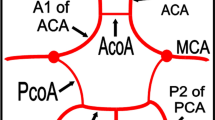Abstract
Background
The morphology of the circle of Willis in adults has been thoroughly discussed in scientific literature. However, the morphology of the circle of Willis in pediatric patients is under-researched.
Objectives
We aimed to establish reference data for the morphology and variations of the circle of Willis in a population consisting of all pediatric age subgroups and to evaluate the possible temporal evolution of the circle of Willis in pediatric patients along with the variations between pediatric and adult populations.
Materials and methods
Our patient cohort included 263 pediatric patients ages 1–215 months. A total of 273 magnetic resonance (MR) angiography images were retrospectively analyzed for all circle of Willis vessels to compare the incidence of complete cases and variation frequency based on gender and age group.
Result
In our study of 273 MR angiograms from all age ranges in the pediatric population, we found a 56.1% circle of Willis completion rate. Overall completion rates were statistically significantly higher in the toddler and preschool age groups. The lowest completion rate was in the newborn-infant group (40%).
Conclusion
Circle of Willis completion rates and variations in pediatric populations are similar to those in adult populations; completion rates rise in toddler and preschooler age groups and decline as children grow into the school-age and adolescent period.




Similar content being viewed by others
References
Osborn AG (1980) Introduction to cerebral angiography. Harper and Row, Hagerstown
Hoksbergen AWJ, Legemate DA, Csiba L et al (2003) Absent collateral function of the circle of Willis as risk factor for ischemic stroke. Cerebrovasc Dis 16:191–198
Zhou H, Sun J, Ji X et al (2016) Correlation between the integrity of the circle of Willis and the severity of initial noncardiac cerebral infarction and clinical prognosis. Medicine (Baltimore) 95:e2892
Jou L-D, Lee DH, Mawad ME (2010) Cross-flow at the anterior communicating artery and its implication in cerebral aneurysm formation. J Biomech 43:2189–2195
Milenkovic Z, Vucetic R, Puzic M (1985) Asymmetry and anomalies of the circle of Willis in fetal brain: microsurgical study and functional remarks. Surg Neurol 24:563–570
Zaninovich OA, Ramey WL, Walter CM, Dumont TM (2017) Completion of the circle of Willis varies by gender, age, and indication for computed tomography angiography. World Neurosurg 106:953–963
Horikoshi T, Akiyama I, Yamagata Z et al (2002) Magnetic resonance angiographic evidence of sex-linked variations in the circle of Willis and the occurrence of cerebral aneurysms. J Neurosurg 96:697–703
Hashemi SMR, Mahmoodi R, Amirjamshidi A (2013) Variations in the anatomy of the Willis’ circle: a 3-year cross-sectional study from Iran (2006-2009). Are the distributions of variations of circle of Willis different in different populations? Result of an anatomical study and review of literature. Surg Neurol Int 4:65
Malamateniou C, Adams ME, Srinivasan L et al (2009) The anatomic variations of the circle of Willis in preterm-at-term and term-born infants: an MR angiography study at 3T. AJNR Am J Neuroradiol 30:1955–1962
Tanaka H, Fujita N, Enoki T et al (2006) Relationship between variations in the circle of Willis and flow rates in internal carotid and basilar arteries determined by means of magnetic resonance imaging with semiautomated lumen segmentation: reference data from 125 healthy volunteers. AJNR Am J Neuroradiol 27:1770–1775
Jin Z-N, Dong W-T, Cai X-W et al (2016) CTA characteristics of the circle of Willis and intracranial aneurysm in a Chinese crowd with family history of stroke. Biomed Res Int 2016:1743794
Krabbe-Hartkamp MJ, van der Grond J, de Leeuw FE et al (1998) Circle of Willis: morphologic variation on three- dimensional time-of- flight MR angiograms. Radiology 207:103–111
Author information
Authors and Affiliations
Corresponding author
Ethics declarations
Conflicts of interest
None
Additional information
Publisher’s note
Springer Nature remains neutral with regard to jurisdictional claims in published maps and institutional affiliations.
Rights and permissions
About this article
Cite this article
Solak, S., Ustabasioglu, F.E., Alkan, A. et al. Anatomical variations of the circle of Willis in children. Pediatr Radiol 51, 2581–2587 (2021). https://doi.org/10.1007/s00247-021-05167-9
Received:
Revised:
Accepted:
Published:
Issue Date:
DOI: https://doi.org/10.1007/s00247-021-05167-9




